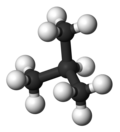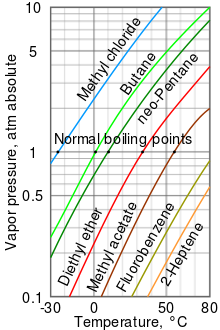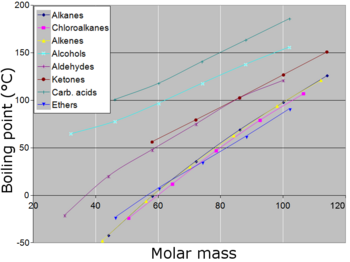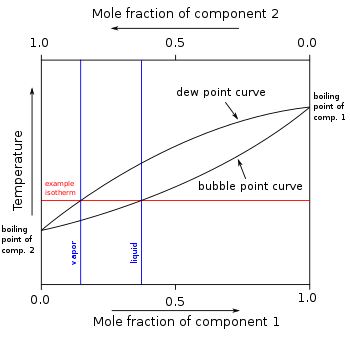Boiling point
The boiling point of a substance is the temperature at which the vapor pressure of the liquid is equal to the pressure surrounding the liquid and it changes to vapor.
The boiling point of a liquid varies according to the ambient pressure around it. A liquid in a partial vacuum has a lower boiling point than when that liquid is at atmospheric pressure. A liquid at high pressure has a higher boiling point than when that liquid is at atmospheric pressure. For example, water boils at 100 °C (212 °F) at sea level, but at 93.4 °C (200.1 °F) at 1,905 meters (6,250 feet) altitude. For a given pressure, different liquids will boil at different temperatures.
The normal boiling point (also called the atmospheric boiling point or atmospheric pressure boiling point) of a liquid is the case special in which the vapor pressure of the liquid is equal to the atmospheric pressure defined at sea level, 1 atmosphere. At that temperature, the vapor pressure of the liquid becomes sufficient to overcome the atmospheric pressure and allow it to form bubbles of vapor within most of the liquid. The standard boiling point has been defined by IUPAC since 1982 as the temperature at which boiling occurs under a pressure of 1 bar.
The heat of vaporization is the energy required to transform a given quantity (one mole, kg, pound, etc.) of a substance from a liquid into a gas at a given pressure (often atmospheric pressure).
Liquids can change to vapor at temperatures below their boiling points through the process of evaporation. Evaporation is a surface phenomenon in which molecules located near the edge of the liquid, which are not contained by sufficient liquid pressure on that side, escape to the surroundings as vapor. On the other hand, boiling is a process in which molecules anywhere in the liquid escape, resulting in the formation of vapor bubbles within the liquid.
The temperature of a substance or body depends on the average kinetic energy of the molecules. At temperatures below boiling point, only a small fraction of the molecules on the surface have enough energy to break the surface tension and escape. This increase in energy constitutes a heat exchange that leads to an increase in the entropy of the system (tendency to disorder of the material points that make up your body).
The boiling point depends on the molecular mass of the substance and the type of intermolecular forces of this substance. To do this, it must be determined if the substance is polar covalent, nonpolar covalent, and determine the type of bonds (permanent dipole —induced dipole or hydrogen bonds—).
The boiling point cannot be raised indefinitely. As the pressure is increased, the density of the gas phase increases until eventually it becomes indistinguishable from the liquid phase with which it is in equilibrium; this is the critical temperature, above which there is no clear liquid phase. Helium has the lowest normal boiling point (–268.9 °C) of any substance, and tungsten the highest (5930 °C).
Standard Boiling Point
In the thermodynamic tables of chemicals, the entire phase diagram is not indicated, only the boiling temperature in the standard state, that is, with a pressure of one atmosphere (1013.25 hPa). This boiling point is called the normal boiling point and the normal boiling point. The term boiling point is often used to refer to the normal boiling point.
The following table shows the boiling temperatures in the standard state (1 atm) in °C:
| H −252.8 | He −268,9 | ||||||||||||||||
| Li 1342 | Be 2471 | B 4000 | C 3825 | N −195,8 | O −183 | F −188.1 | Ne −246,1 | ||||||||||
| Na 882,9 | Mg 1090 | Al 2519 | Yeah. 3265 | P 280.5 | S 444.6 | Cl −34 | Ar −185.8 | ||||||||||
| K 759 | Ca 1484 | Sc 2836 | Ti 3287 | V 3407 | Cr 2671 | Mn 2061 | Fe 2861 | Co 2927 | Ni 2913 | Cu 2562 | Zn 907 | Ga 2204 | Ge 2833 | As 616 | Separate 685 | Br 58.8 | Kr −153.3 |
| Rb 688 | Mr. 1382 | And 3345 | Zr 4409 | Nb 4744 | Mo 4639 | Tc 4265 | Ru 4150 | Rh 3695 | Pd 2963 | Ag 2162 | Cd 767 | In 2072 | Sn 2602 | Sb 1587 | You 988 | I 184,4 | Xe −108.1 |
| Cs 671 | Ba 1897 | ♪ | Hf 4603 | Ta 5458 | W 5930 | Re 5627 | You 5012 | Go 4428 | Pt 3825 | Au 2856 | Hg 356,6 | Tl 1473 | Pb 1749 | Bi 1564 | Po 962 | At | Rn −61.7 |
| Fr 677 | Ra 1737 | ** | Rf | Db | Sg | Bh | Hs | Mt | Ds | Rg | Cn | Nh | Fl | Mc | Lv | Ts | Og |
| ♪ | La 3464 | Ce 3443 | Pr 3520 | Nd 3074 | Pm 3000 | Sm 1794 | Eu 1529 | Gd 3273 | Tb 3230 | Dy 2567 | Ho 2700 | Er 2868 | Tm 1950 | Yb 1196 | Lu 3402 | ||
| ** | Ac 3198 | Th 4788 | Pa 4027 | U 4131 | Np 4273 | Pu 3228 | Am 2011 | Cm 3100 | Bk | Cf | That's it. | Fm | Md | No. | Lr | ||
Saturation temperature and pressure
A saturated liquid contains as much thermal energy as it can without boiling (or, conversely, a saturated vapor contains as little thermal energy as possible without condensation).
The saturation temperature means boiling point. The saturation temperature is the temperature for a corresponding saturation pressure at which a liquid boils into its vapor phase. It can be said that the liquid is saturated with thermal energy. Any addition of thermal energy results in a phase transition.
If the pressure in a system remains constant (isobaric), a vapor at saturation temperature will begin to condense into its liquid phase as thermal energy (heat) is removed. Similarly, a liquid at saturation temperature and pressure will boil into its vapor phase as additional heat energy is applied.
The boiling point corresponds to the temperature at which the vapor pressure of the liquid is equal to the surrounding ambient pressure. Therefore, the boiling point depends on the pressure. Boiling points may be published with respect to the NIST, US standard pressure of 101.325 kPa (or 1 atm), or the IUPAC standard pressure of 100,000 kPa. At higher elevations, where the atmospheric pressure is much lower, the boiling point is also lower. The boiling point increases with increasing pressure up to the critical point, where the properties of the gas and the liquid become identical. The boiling point cannot be increased beyond the critical point. Similarly, the boiling point decreases with decreasing pressure until the triple point is reached. The boiling point cannot be lowered below the triple point.
If the heat of vaporization and the vapor pressure of a liquid at a certain temperature are known, the boiling point can be calculated using the Clausius-Clapeyron equation, therefore:
| Symbol | Name | Value | Unit |
|---|---|---|---|
| TB{displaystyle T_{B}} | Normal boiling point | K | |
| T0{displaystyle T_{0}} | Known temperature | K | |
| P0{displaystyle P_{0}} | Known pressure | Pa | |
| P{displaystyle P} | Steam pressure to T0{displaystyle T_{0}} | Pa | |
| R{displaystyle R} | Universal gas strength | 8.314 | J/ (mol K) |
| Δ Δ Hv{displaystyle Delta H_{v}} | Steaming detail | J/ mol |
The saturation pressure is the pressure at a corresponding saturation temperature at which a liquid boils into its vapor phase. Saturation pressure and saturation temperature have a direct relationship: as saturation pressure increases, so does saturation temperature.
If the temperature in a system remains constant (an isothermal system), steam at saturation pressure and temperature will begin to condense into its liquid phase as the pressure of the system increases. Similarly, a liquid at saturation pressure and temperature will tend to flash into its vapor phase as the system pressure decreases.
There are two conventions regarding the standard boiling point of water: the normal boiling point is 99.97 °C (211.9 °F) at a pressure of 1 atm (i.e. 101.325 kPa). The IUPAC recommended standard boiling point of water at a standard pressure of 100 kPa (1 bar) is 99.61 °C (211.3 °F).. For comparison, at the top of Mount Everest, at an elevation of 8,848 m (29,029 ft), the pressure is about 34 kPa (255 Torr) and the boiling point of water is 71 °C (160 °F).. The Celsius temperature scale was defined until 1954 by two points: 0 °C was defined by the freezing point of water and 100 °C was defined by the boiling point of water at standard atmospheric pressure.
Relation between the normal boiling point and the vapor pressure of liquids
The higher the vapor pressure of a liquid at a given temperature, the lower the normal boiling point (ie, the boiling point at atmospheric pressure) of the liquid.
The vapor pressure graph to the right has graphs of vapor pressures versus temperatures for a variety of liquids. As can be seen on the graph, liquids with the highest vapor pressures have the lowest normals boiling points.
For example, at any given temperature, methyl chloride has the highest vapor pressure of any of the liquids on the graph. It also has the lowest normal boiling point (−24.2 °C), which is where the methyl chloride vapor pressure curve (the blue line) crosses the horizontal one atmosphere (atm) vapor pressure line. absolute.
The critical point of a liquid is the highest temperature (and pressure) at which it will actually boil.
Element properties
The element with the lowest boiling point is helium. Both rhenium and tungsten boiling points exceed 5000 K at standard pressure; Because it is difficult to measure temperature extremes precisely without bias, both have been cited in the literature as having a higher boiling point.
Boiling point as a reference property of a pure compound
As can be seen from the above plot of log vapor pressure versus temperature for any given pure chemical compound, its normal boiling point can serve as an indication of that compound's overall volatility. A given pure compound has only one normal boiling point, if any, and the normal boiling point and melting point of a compound can serve as characteristic physical properties of that compound, listed in reference books. The higher the normal boiling point of a compound, the less volatile the compound in general, and conversely, the lower the normal boiling point of a compound, the more volatile the compound in general. Some compounds decompose at higher temperatures before reaching their normal boiling point, or even sometimes their melting point. For a stable compound, the boiling point varies from its triple point to its critical point, depending on the external pressure. Beyond its triple point, a compound's normal boiling point, if any, is higher than its melting point. Beyond the critical point, the liquid and vapor phases of a compound merge into a single phase, which can be referred to as a superheated gas. At any given temperature, if a compound's normal boiling point is lower, that compound will generally exist as a gas at atmospheric external pressure. If the normal boiling point of the compound is higher, then that compound can exist as a liquid or solid at that given temperature at external atmospheric pressure, and so will exist in equilibrium with its vapor (if volatile) if its vapors are contained. If the vapors of a compound are not contained, some volatile compounds can evaporate despite their higher boiling points.
In general, compounds with ionic bonds have high normal boiling points, if they don't decompose before reaching such high temperatures. Many metals have high boiling points, but not all. Generally, in compounds with covalently bonded molecules, as the size of the molecule (or molecular mass) increases, the normal boiling point increases. When the molecular size becomes that of a macromolecule, polymer, or otherwise very large, the compound often decomposes at high temperature before boiling point is reached. Another factor that affects the normal boiling point of a compound is the polarity of its molecules. As the polarity of a compound's molecules increases, its normal boiling point increases, other factors being equal. It is closely related to a molecule's ability to form hydrogen bonds (in a liquid state), making it more difficult for molecules to leave the liquid state and thus increasing the normal boiling point of the compound. Simple carboxylic acids dimerize by forming hydrogen bonds between molecules. A minor factor that affects boiling points is the shape of a molecule. Making a molecule's shape more compact tends to lower the normal boiling point slightly compared to an equivalent molecule with more surface area.
| Common name | n-butan | isobutano |
|---|---|---|
| Name of IUPAC | butano | 2-methylpropain |
| Molecular shape |  |  |
| Evaporation point (°C) | −0.5 | −11.7 |
Most volatile compounds (anywhere near room temperature) go through an intermediate liquid phase while heating up from a solid phase to ultimately transform into a vapor phase. Compared to boiling, a sublimation is a physical transformation in which a solid turns directly into a vapor, which occurs in a few select cases, such as with carbon dioxide at atmospheric pressure. For such compounds, a sublimation point is a temperature at which a solid that is converted directly to a vapor has a vapor pressure equal to the external pressure.
Impurities and mixtures
In the previous section, we covered the boiling points of pure compounds. The vapor pressures and boiling points of substances can be affected by the presence of dissolved impurities (solutes) or other miscible compounds, the degree of effect depending on the concentration of the impurities or other compounds. The presence of non-volatile impurities such as salts or compounds of much lower volatility than the main component compound lowers its mole fraction and the volatility of the solution and therefore raises the normal boiling point in proportion to the concentration of the compounds. solutes. This effect is called boiling point elevation. As a common example, salt water boils at a higher temperature than pure water.
In other mixtures of miscible compounds (components), there may be two or more components of variable volatility, each with its own boiling point of pure component at any given pressure. The presence of other volatile components in a mixture affects the vapor pressures and therefore the boiling and dew points of all components in the mixture. The dew point is a temperature at which a vapor condenses into a liquid. Also, at any given temperature, the composition of the vapor is different from the composition of the liquid in most of these cases. To illustrate these effects between the volatile components of a mixture, a boiling point diagram is commonly used. Distillation is a boiling and [usually] condensing process that takes advantage of these differences in composition between the liquid and vapor phases.
Contenido relacionado
Germanium
Hourglass
Wikipedia:Unesco 6-digit classification/22 Physics














